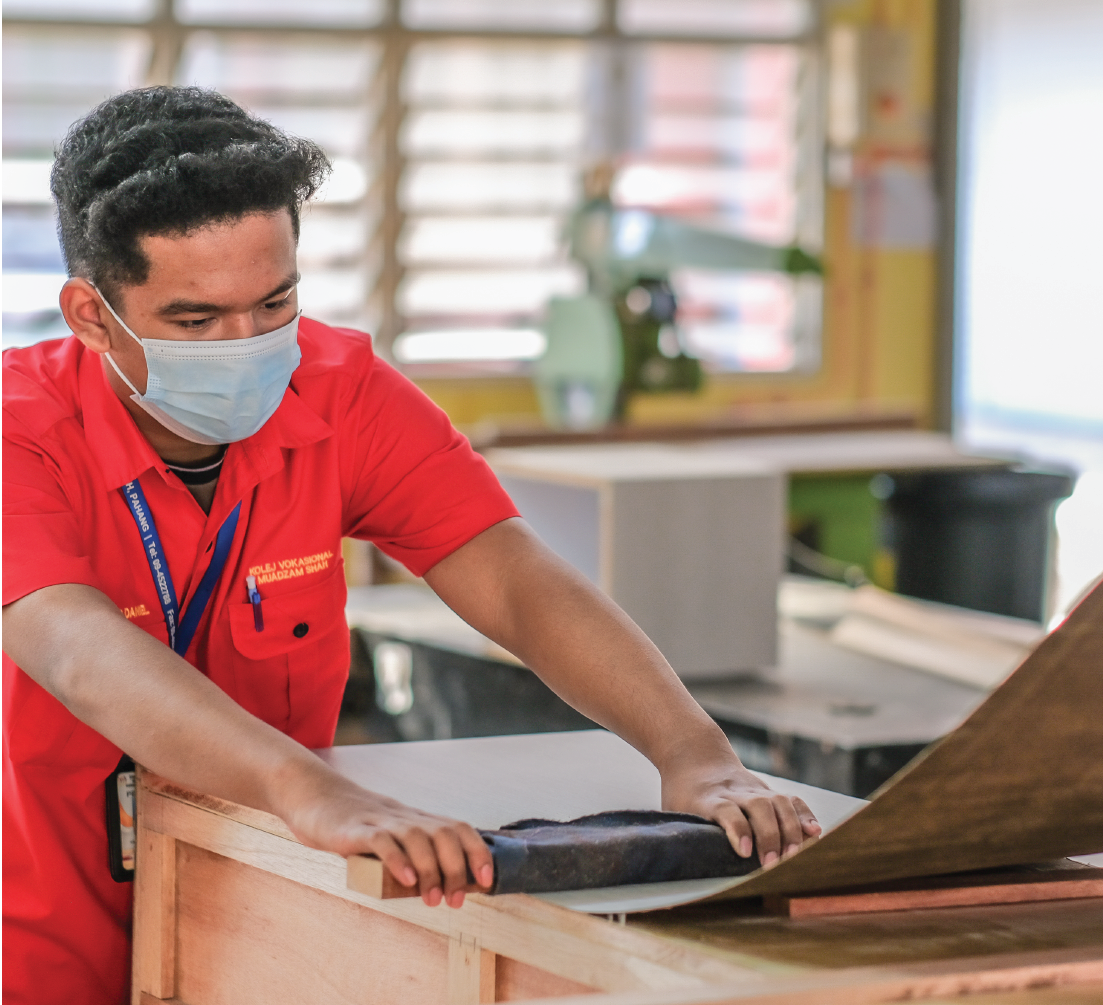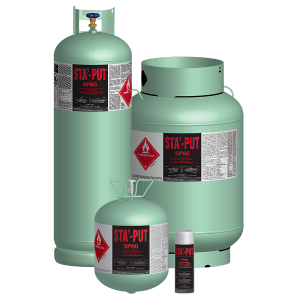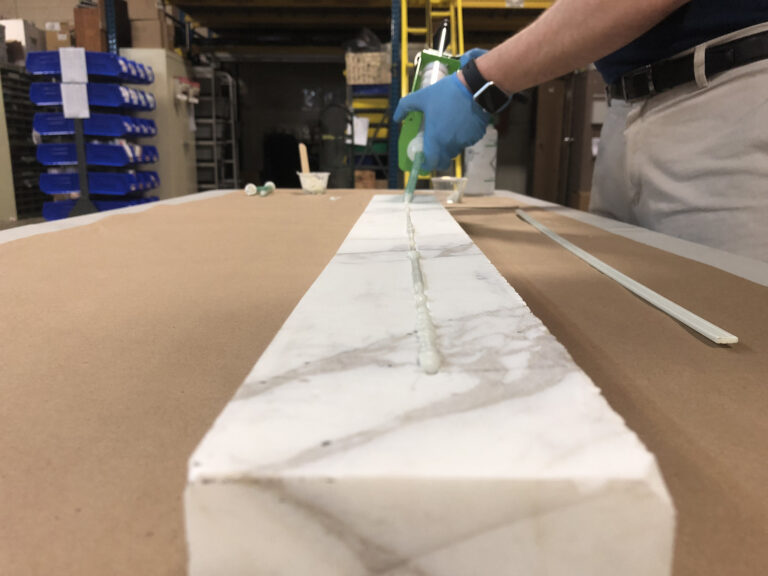
6 Adhesive Types for Stone – Explained for Fabricators
There are a lot of misconceptions about adhesives in the stone and countertop fabrication industry. In this article, we clear the air by breaking down the different adhesive types in stone fabrication

Countertop and stone fabricators use adhesives for a variety of applications. As such, we get a lot of questions from fabricators about the adhesives they’re using and if they’re using the right adhesive for the job.
Being the adhesive experts, we wanted to put together this list of commonly used adhesives in the stone industry. Under each adhesive category we’ll list out some basic facts, common applications, pros, and cons, as well as common examples, so you can see if you’re using the right product for the job.
Let’s dive in.
Stone Fabrication Adhesive Types
#1. Polyester Stone Adhesives
What are they?
Polyester adhesives are one of the most common stone fabrication glues in the industry.
Unlike other adhesives on this list, polyester resins are not commonly used as an adhesive in many other industries. They are used in auto body repair, the marine industry, manufacturing of fiberglass composites, and in other masonry trades, but typically they are used for interior applications and mostly as filler or prepreg rather than as an adhesive.
These are two-component products with a resin base and a hardener, often with high resin-to-hardener ratios such as 200:1 or 400:1. They’re usually sold in bulk – quarts, gallons, or 5 gallons buckets. Some polyester resins are packaged in cartridges but due to the odd ratios, polyesters are not well-suited for this type of packaging. Polyester resins are usually unpigmented or sold in neutral base tones that need to be tinted by hand so end results vary depending on the skills of the user.
What are they used for?
They’re used for all types of countertop fabrication applications including seaming, rodding and chip repairs. However, due to some of the pros and cons we’re about to cover, they are probably best suited for crack filling and working in low visibility areas – and only indoors. Here’s why.
Pros
Starting with the pros, polyester stone adhesives are relatively low-cost. That is the main reason a lot of fabricators use them in the shop and onsite as their workhorse adhesives. They also cure relatively quickly, which makes them hard to resist for installers who want to get out and on to the next job as soon as possible.
But be warned – with polyester adhesives, you usually get what you pay for.
Cons
Polyesters are a low-cost resin and inherently inferior to epoxies and acrylics in many important ways:
- Low strength; not a structural adhesive
- Lower resistance to wear
- Poor environmental resistance
- Polyester is water-permeable; not suitable for metal rods or areas where water ingress is a concern
- Difficult ratios make quality control a challenge
- Hand pigmenting requires highly skilled users; steep learning curve for new hires
- Higher shrinkage than epoxies or acrylics; may contain solvents
- Higher toxicity than epoxy or acrylics
- High odor
- Short shelf life
- Not UV stable: suitable for interior only
While polyesters are functional and widely used, the biggest problem is that many of the above factors can compound the labor challenges that fabrication shops are facing today. Mix ratios like 400:1 are impossible to measure accurately by eye, and fabrication shops rarely, if ever will use a scale to get a proper mix. So if quality control is important to you, then ratios like this should be a red flag.
We also see fabricators that will add in more hardener than the ratio specifies to speed up the cure time. This makes the adhesive more brittle and results in an overall decrease in performance. So it’s important to always follow the recommended mix ratio and employ some quality control to ensure accuracy.
Another downside is they need pigment mixed in onsite. It can be challenging for new fabricators to get an exact color match. We also see fabricators use cardboard to mix the pigment into the adhesive, and this can lead to coloration leeching from the cardboard. If you want to mix up high-quality whites consistently, you need to avoid the cardboard and you might want to consider premixed colors if you really want a scalable solution.
To top it off, polyester adhesives will never be classified as a structural adhesive. The bonds are too weak for most structural jobs, like rodding. They’re also not very environmental or chemical resistant. They’re easily penetrated by water, which can lead to rust if paired with steel rods. This is known as countertop cancer or rod jacking. This can be very costly to a fabrication shop and can be easily avoided by using epoxy or acrylic rodding adhesives.
Examples of Polyester Adhesives
A lot of people may be using polyesters and not be aware. Many fabricators will use the term “epoxy” to describe any two-part resin adhesive. You also see adhesives referred to as ”knife-grade” or “flowing” adhesives without any mention of the chemistry. Epoxies are another type of adhesive entirely, and knife-grade only describes the consistency of the adhesive. Rather than using generic terms, try to be specific when discussing adhesives around the shop. It will help your coworkers, your employees, and your suppliers when everyone communicates more clearly and learns the tools of the trade.
Some common examples of polyester adhesives include Superior Bronze, K-Bond Polyester, and Tenax Knifegrade
#2. Vinyl Ester Stone Adhesives
What are they?
Vinyl ester (VE) adhesives are a lot like polyester adhesives. In terms of performance and price point, they are somewhere in between polyesters and true epoxies. They are moderately stronger than polyesters and have generally better mechanical properties. They’re also sold in bulk, but some manufacturers have cartridges available.
What are they used for?
Vinyl esters are used for all kinds of countertop applications including seaming, rodding, and repair. Since they are stronger than polyesters, they are a better option for jobs where performance matters.
Pros
The pros of vinyl esters start with more strength. They still aren’t the strongest stone adhesive out there, but they are a step up from polyesters.
They’re also very chemical resistant, but this usually doesn’t matter in routine kitchen jobs. It’s still good to know should you need something with chemical resistance. They can stand up to most household cleaners without noticeable yellowing for quite some time. Vinyl ester is also less prone to water absorption than polyester so VE would be a better choice than polyester for any application that is exposed to water.
Cons
Vinyl ester adhesives still carry some of the same cons as their polyester counterparts. They are stronger but not strong enough for some structural bonding jobs.
Shrinkage is another concern. Both polyester and vinyl esters shrink up to 7%, in comparison to epoxies which typically have shrinkage < 2%. Vinyl esters are also less stable and will have inferior cosmetics over a long period of time.
Vinyl esters also have inferior shelf life and shelf stability compared to epoxy. Typically vinyl esters have about ~ 6 mo shelf life. Epoxies and acrylics often have 18 months or even 2 years of shelf life.
While the performance would be an improvement compared to polyester adhesives, they are still not in the same class as true structural adhesives. If you are looking for superior performance, you might as well go right for epoxy or acrylic, since the cost of the adhesive is still a small fraction of the cost of a countertop.
Examples of Vinyl Ester Adhesives
Some common examples of vinyl ester adhesives include Superior V-Max and Tenax Titanium adhesives. These options come in cartridges, so it’s important to look at the chemistry. Not all cartridges are the same.
#3. Epoxy Stone Adhesives
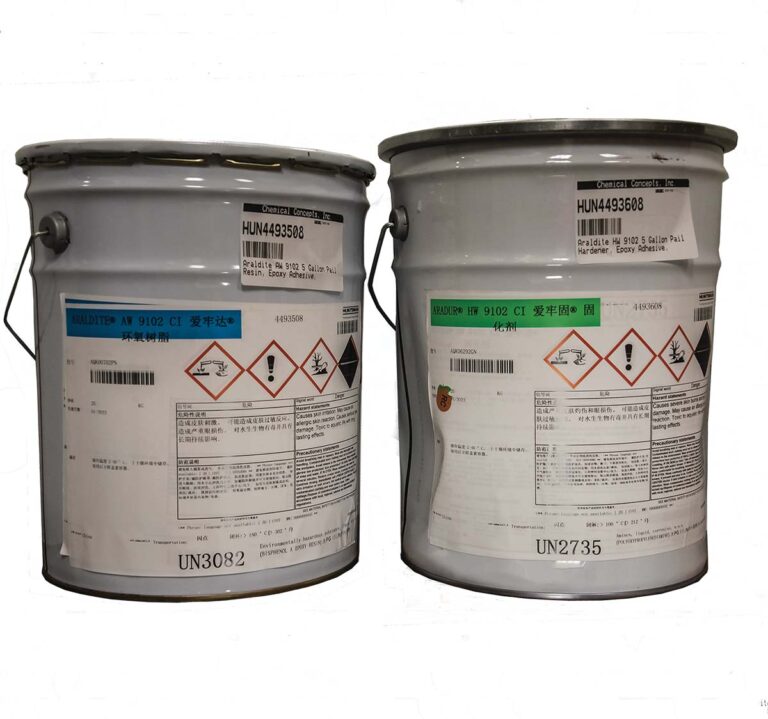
What are they?
The first thing to know about epoxies is that not everything that people call an epoxy is a true epoxy. People often use the term “epoxy” to mean any stone adhesive.
True epoxies are a higher quality resin adhesive that is sold in both cartridges and bulk. Unlike polyester or vinyl esters, epoxies typically offer mixing ratios of 1:1 or 2:1 which makes them better suited for cartridge packaging. In general, they are available in a wide range of sizes, viscosities, ratios, and cure times.
One thing to note on the cure time, with epoxies, the higher the cure time, the stronger the bond. Keep that in mind when you’re looking for the epoxy that’s right for your jobs.
What are they used for?
They are used for a lot of different jobs. Some grades are for interior use only while other epoxy-based products can be used exterior. They are good for mitering, seaming, and rodding. They can also be used to fill pits, and they can be used in slab production to consolidate the material, fill imperfections or apply fiberglass or composite mesh to the slabs to reinforce the slab for shipping and handling. Epoxies are also the adhesive of choice for honeycomb stone lamination.
Due to their longer cure times, they can be inconvenient for installers working on-site, but you can work with these times in the shop and many installers choose to focus on quality above speed.
Pros
The pros of epoxies start with strength. They create very durable strong bonds that are chemical and environmentally resistant, so they can easily be used indoors and outdoors. They aren’t inherently UV resistant, but some products have UV stabilizers added to improve the resistance to yellowing which would occur with direct UV exposure over time.
Their lower mixing ratios are much easier to work with. They are also available with a wide range of features and options, so you can pick the epoxy that is right for your job. They also have a shelf life that can last up to two years under the right conditions.
Cons
The cons start with cure times. They can take a while to fully cure which can hamper your productivity onsite and in the shop. Plus faster setting epoxies are typically not as strong as their slower curing counterparts. So if you want speed, then you need to compromise on strength or look for an acrylic adhesive.
True epoxies are also a bit more expensive than other adhesives, and for some projects, the strength might be overkill.
Examples of Epoxies
Some popular examples of epoxies include Chem-Set 633, Akemi Akepox 5010, Bonstone Invisibond and T2000
#4. Acrylic Stone Adhesives
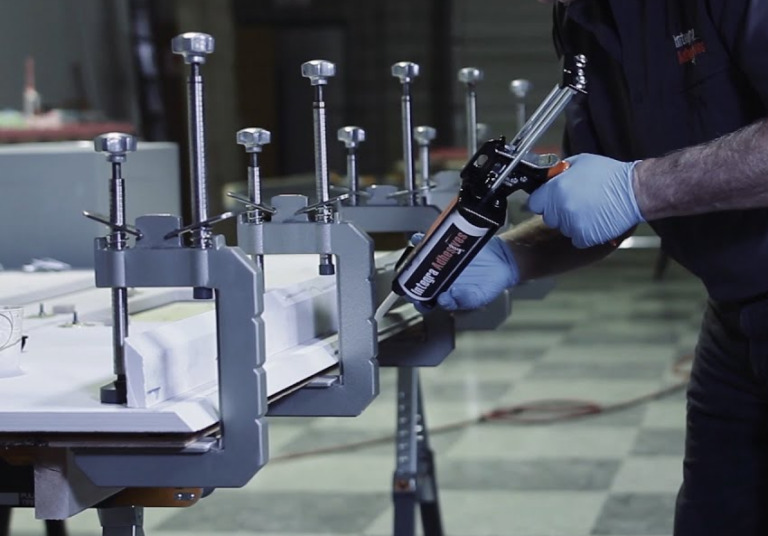
What are they?
Next, we have acrylic stone adhesives. This adhesive type gives you the best of both worlds when it comes to strength and cure times. Acrylic adhesives cure exponentially, building the bulk of their strength early in the curing process. They then slowly build to full cure over 24 hours.
Acrylics are sold mostly in cartridges, although there are some bulk options available. They come in mixing ratios ranging from 10:1 to 1:1. On top of that, there are a lot of cure time options.
Acrylics became popular as fabricators experimented with seam kits designed for solid surface countertops and started using them on seams for natural stone and quartz. A lot of people refer to acrylics as Corian adhesives. Acrylics bond to a lot of different surfaces, making them a great option for all natural and engineered stone surfaces.
What are they used for?
Acrylics are used for the full range of countertop fabrication jobs including seaming, mitering, rodding, sink mounting, and anchoring. They’re mostly used indoors, but there are options rated for outdoor use.
Pros
Acrylics have a lot going for them. To start, they form high-strength bonds with relatively low cure times. They also have better strength development compared to epoxies – meaning acrylic adhesives will typically achieve 80% of their ultimate strength in the first few hours when you need it most. Epoxies will cure slowly over time, so your joint won’t achieve 80% strength for many hours. Acrylics also come in easy-to-mix ratios, which makes them easy to use on the job for anyone. They are also available with pre-mixed colors which ensures that you can easily match all your surfaces. Quality control and contamination control are much easier to account for compared to other adhesives.
With a variety of fast cure times, you can quickly go from job to job or keep production moving in your shop environment without comprising on quality.
Acrylics are also low VOC, which makes them ideal for use on public building projects.
Cons
Acrylics are not the cheapest products available for bonding stone. If you’re used to using something like polyester, you might have some sticker shock at acrylic products. However, you do get what you pay for in terms of performance. If low cost is a huge priority and quality is not, then acrylics might not be the best fit for you.
Acrylics are also not great for outdoor use unless they are specifically rated for it. Acrylics will not break down with UV, but the color will be affected. Whites and other light colors will yellow over time with direct exposure, but some products will work better than others depending on the quality and the amount of UV stabilizers that are added.
While they do have a great shelf life of 18 to 24 months, you need to store them in a controlled environment around 60-70 degrees Fahrenheit. If you have an air-conditioned area of your building, that would work, or even better, refrigeration will extend the shelf life even further. If you use a lot of acrylic adhesives, it may be worthwhile to pick up a second-hand refrigerator to store colors that do not turn as quickly. They’re also considered hazardous to ship, so that increases your shipping costs, especially if you do not plan ahead with your purchasing.
Examples of Acrylic Adhesives
Perhaps the best-known acrylic adhesive in the industry is the Integra Surface Bonder XI, as well as Integra Zero, Integra Rapid, Component Bonder, and Rodding Bonder. Other examples of acrylic adhesives are the Chem-Set Stone Seam, and Rodmaster.
#5 Urethane-Based or Polyaspartic Stone Adhesives
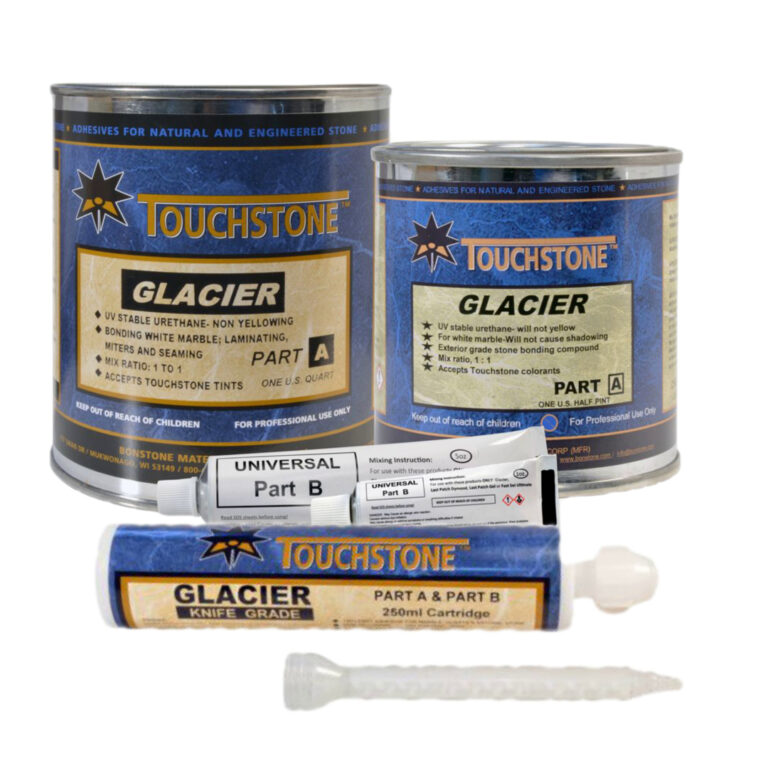
What are they?
Urethane-based or polyaspartic adhesives are a bit of a novelty in the stone fabrication industry. They originated in applications as a non-yellowing coating in the flooring industry. As a result of their excellent exterior and UV resistance, these adhesives are used in many outdoor kitchen applications.
What are they used for?
Like we said above, polyaspartics are the best choice for outdoor deck seams and miters. They can be used for a variety of seaming jobs, and their color stands up to environmental factors like sunlight very well. These adhesives are also the weapon of choice for seaming on porcelain and sintered stones for both interior and exterior projects. Polyaspartics are also recommended for quartzites and other delicate stones that are prone to stains or bleeding.
Pros
These adhesives are great for creating seams for outdoor applications. They will remain true to their color with zero-yellowing even with direct UV exposure, making outdoor kitchens look great even with light colors and white surfaces. They also work well on porcelain and sintered stone products like Dekton and Neolith. These adhesives are unique for their high flexibility allowing for joint movement. This is especially important outdoors where materials can expand and contract at different rates due to temperature changes. Polyaspartic adhesives are also non-bleeding which is great for quartzites like Crystalo or Taj Mahal. Due to the cost of these slabs, it is worthwhile to spend a bit more on your adhesives and eliminate any risk of a costly stain or bleed in your joint.
Cons
The biggest con for polyaspartic adhesives is cost. These are some of the highest-cost adhesives per milliliter in the stone industry so they are not ideal for use on every job, but if you need the outdoor performance and/or zero yellowing, there is no substitute. They also take a while to fully cure, only getting a structural cure after 60 minutes.
Examples of Polyaspartic Adhesives
Some common examples of polyaspartic adhesives include Integra Ultra and Bonstone Glacier.
#6. Cyanoacrylate Stone Adhesives
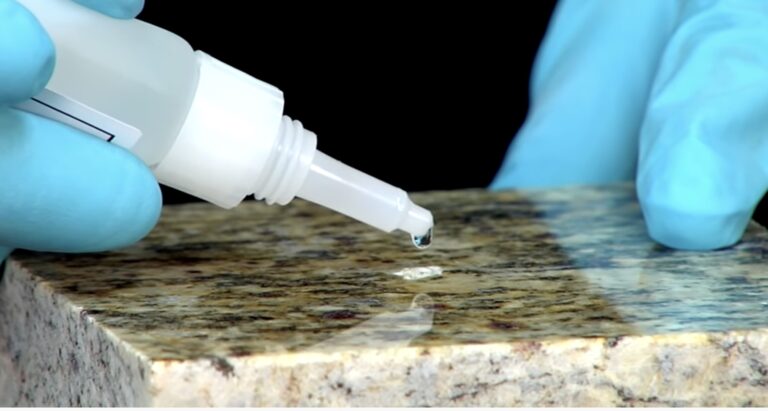
What are they?
Cyanoacrylate adhesives (CA for short) are what most people would think of as “super glue.” They are a one-part, typically clear adhesive that are water-thin in viscosity. Their uses are rather limited in stone fabrication, but we included them on this list because we have seen people use them from time to time.
What are they used for?
In stone fabrication, CAs should only be used for chip fills with natural stone. They are not structural adhesives. However, some shops do use CAs for deck seams and repairs.
Pros
CAs cure very fast and with the use of an activator they can cure almost “instantly”. They are high clarity and they are very easy to use. They are available in many different grades and thicknesses.
Cons
CAs have limited applications for the stone industry. They dry out quickly once opened, so they need to be stored in refrigeration to slow the drying in the container. CAs are also very brittle and not nearly as strong as epoxies or acrylics.
Examples of Cyanoacrylate Adhesives
Some notable examples of CAs include Chem-Set Stone Repair Kits, and Hot Stuff.
Conclusion
The bottom line is you need to know the chemistry of the products you’re using so you can be sure that they’re the right adhesives for the job. At Chemical Concepts, we carry a variety of stone adhesives. Most notably, we carry many Integra acrylic adhesive products perfect for any countertop fabrication job.
When it comes down to sheer performance, we tend to agree that acrylic adhesives are the best all-around adhesives for stone countertop fabrication.
Take a look at the full selection here. Also, be sure to use our Integra Color Match Tool to get the perfect match for any seaming job on any surface.
Chemical Concepts has decades of experience serving the countertop fabrication industry. Have questions or looking for a custom solution? Call us to talk to one of our experts today.
-
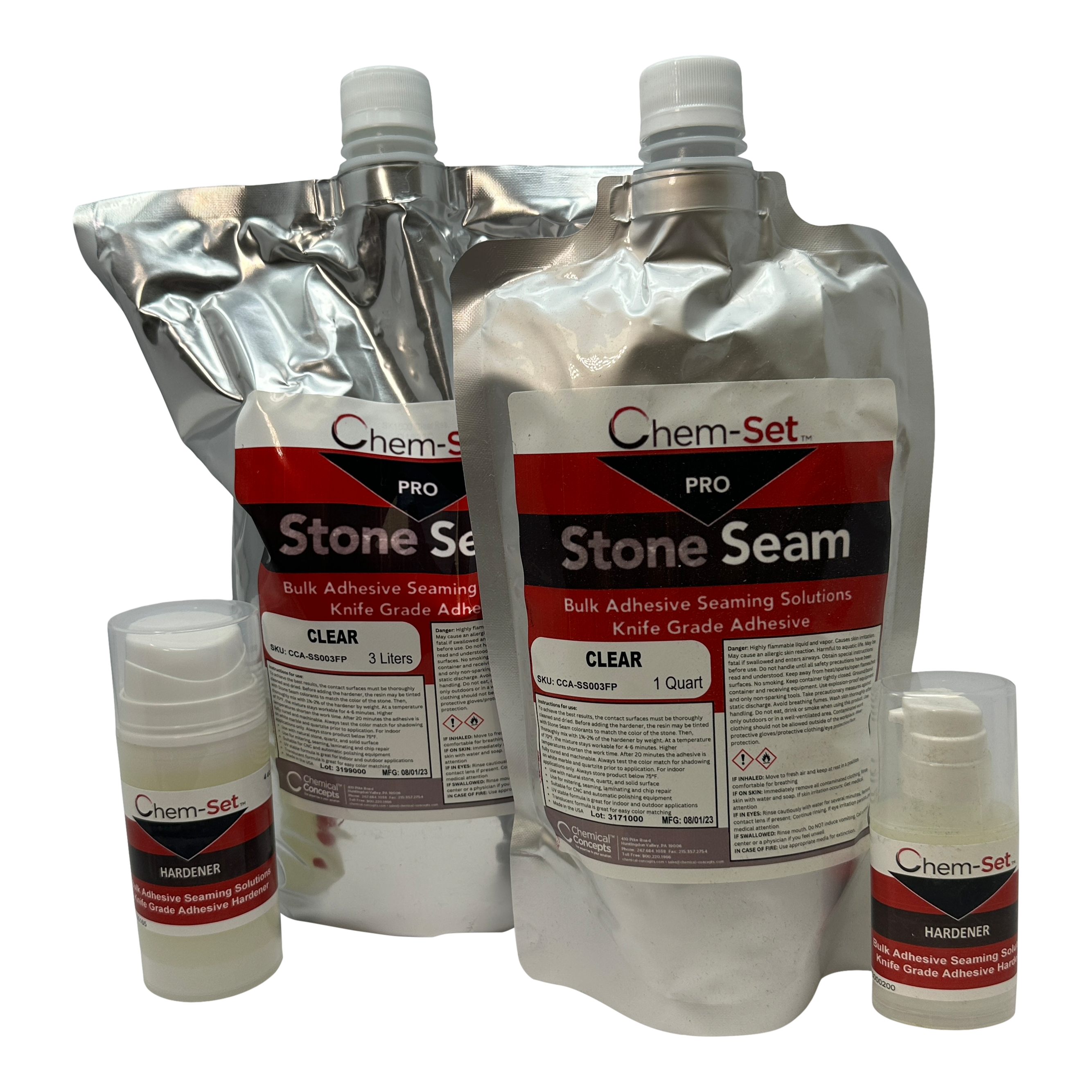 Stone Seam Pro 1500 Clear Knife Grade AdhesiveOur Price Starting at From: $58.81
Stone Seam Pro 1500 Clear Knife Grade AdhesiveOur Price Starting at From: $58.81 -
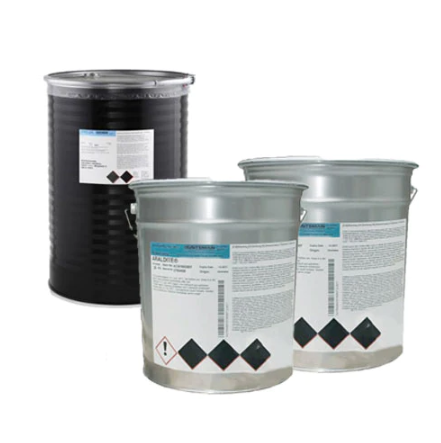 Araldite 9102 Honeycomb Panel Bonding Adhesive KitOur Price Starting at $775.29
Araldite 9102 Honeycomb Panel Bonding Adhesive KitOur Price Starting at $775.29 -
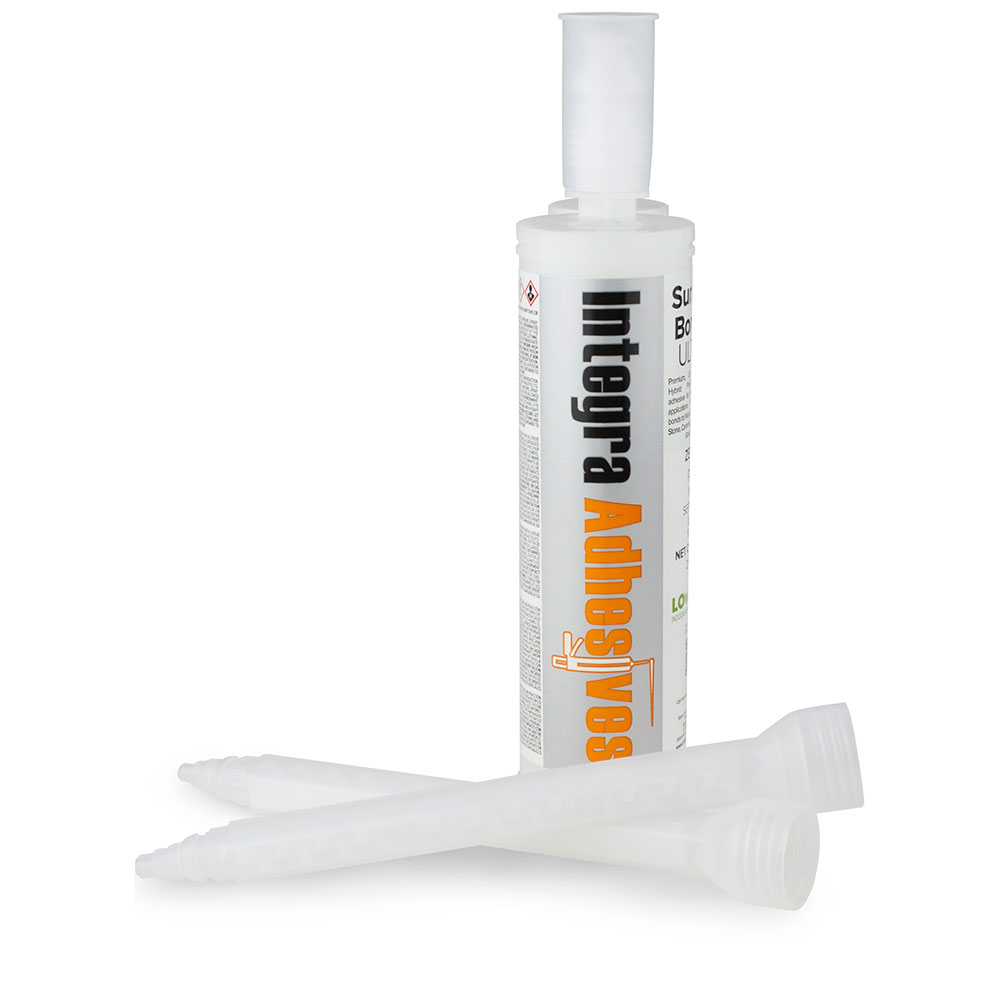 Integra Surface Bonder UltraOur Price Starting at From: $51.27
Integra Surface Bonder UltraOur Price Starting at From: $51.27 -
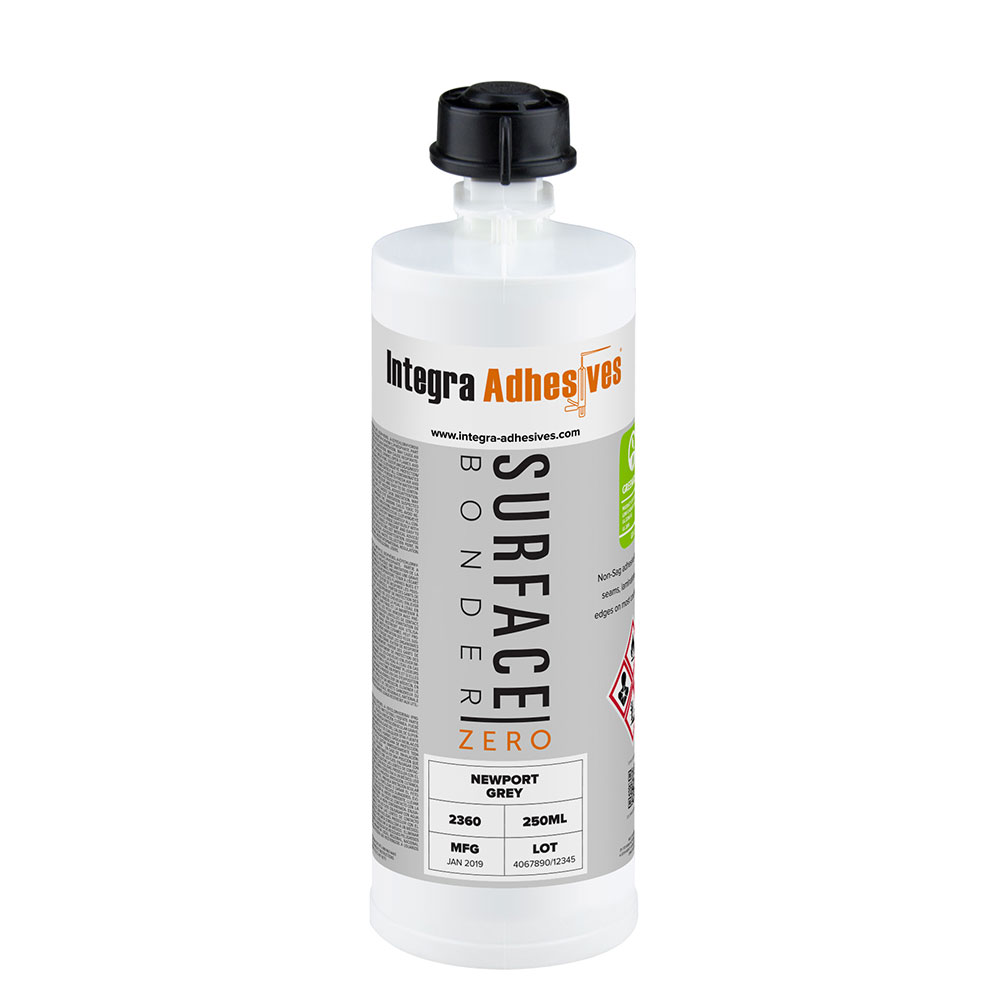 Integra Surface Bonder ZERO Seaming Adhesive – 250ml CartridgeOur Price Starting at From: $25.49
Integra Surface Bonder ZERO Seaming Adhesive – 250ml CartridgeOur Price Starting at From: $25.49 -
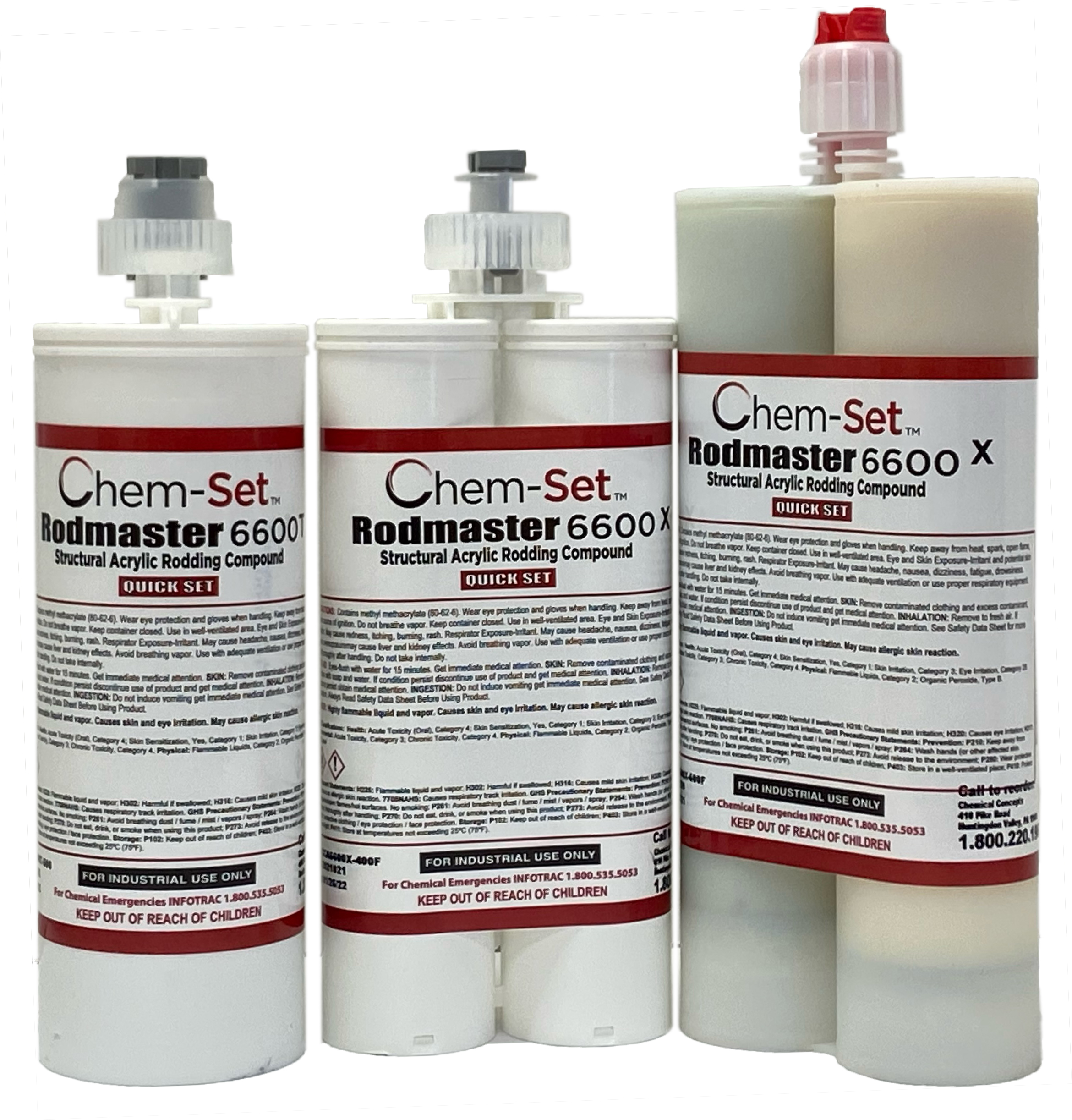 Chem-Set™ Rodmaster 6600X (1:1) Rodding AdhesiveOur Price Starting at From: $45.72
Chem-Set™ Rodmaster 6600X (1:1) Rodding AdhesiveOur Price Starting at From: $45.72 -
 Chem-Set™ 633 5 Minute Gel Epoxy AdhesiveOur Price Starting at From: $7.75
Chem-Set™ 633 5 Minute Gel Epoxy AdhesiveOur Price Starting at From: $7.75 -
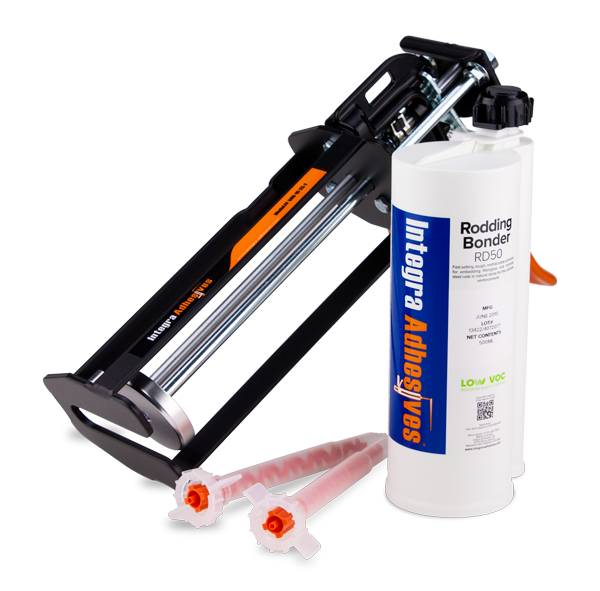 Integra Rodding Bonder RD50 500ML W/ 4 TipsOur Price Starting at $37.50
Integra Rodding Bonder RD50 500ML W/ 4 TipsOur Price Starting at $37.50 -
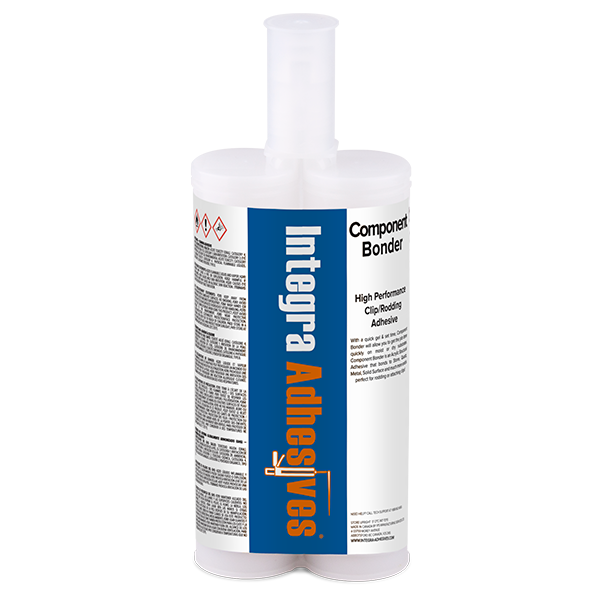 Integra Component Bonder 400ML W/2 TipsOur Price Starting at $30.30
Integra Component Bonder 400ML W/2 TipsOur Price Starting at $30.30 -
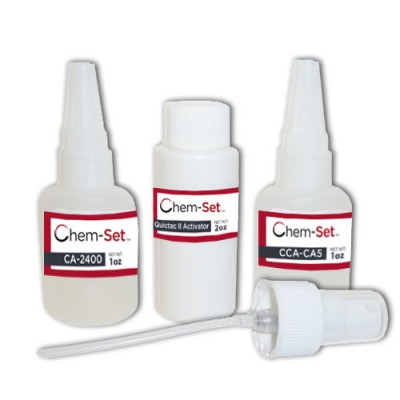 Chem-Set CCA800 CA Glue Chip Repair Kit for StoneOur Price Starting at $28.90
Chem-Set CCA800 CA Glue Chip Repair Kit for StoneOur Price Starting at $28.90

